Xiaomi Mi 5 vs Samsung Galaxy S7
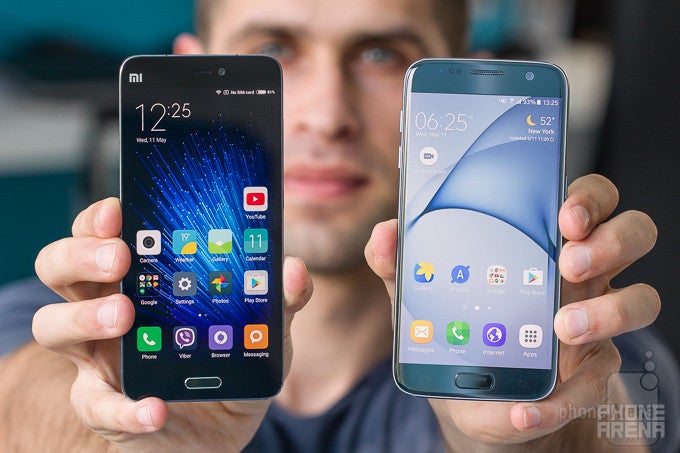
Introduction
Xiaomi is big in China: the company started by making Apple clones and selling them for super affordable prices, but it has now largely moved past that stage. For quite some time, it’s been hard at work to bring a new flagship and recently, it’s finally released it: the Xiaomi Mi 5.
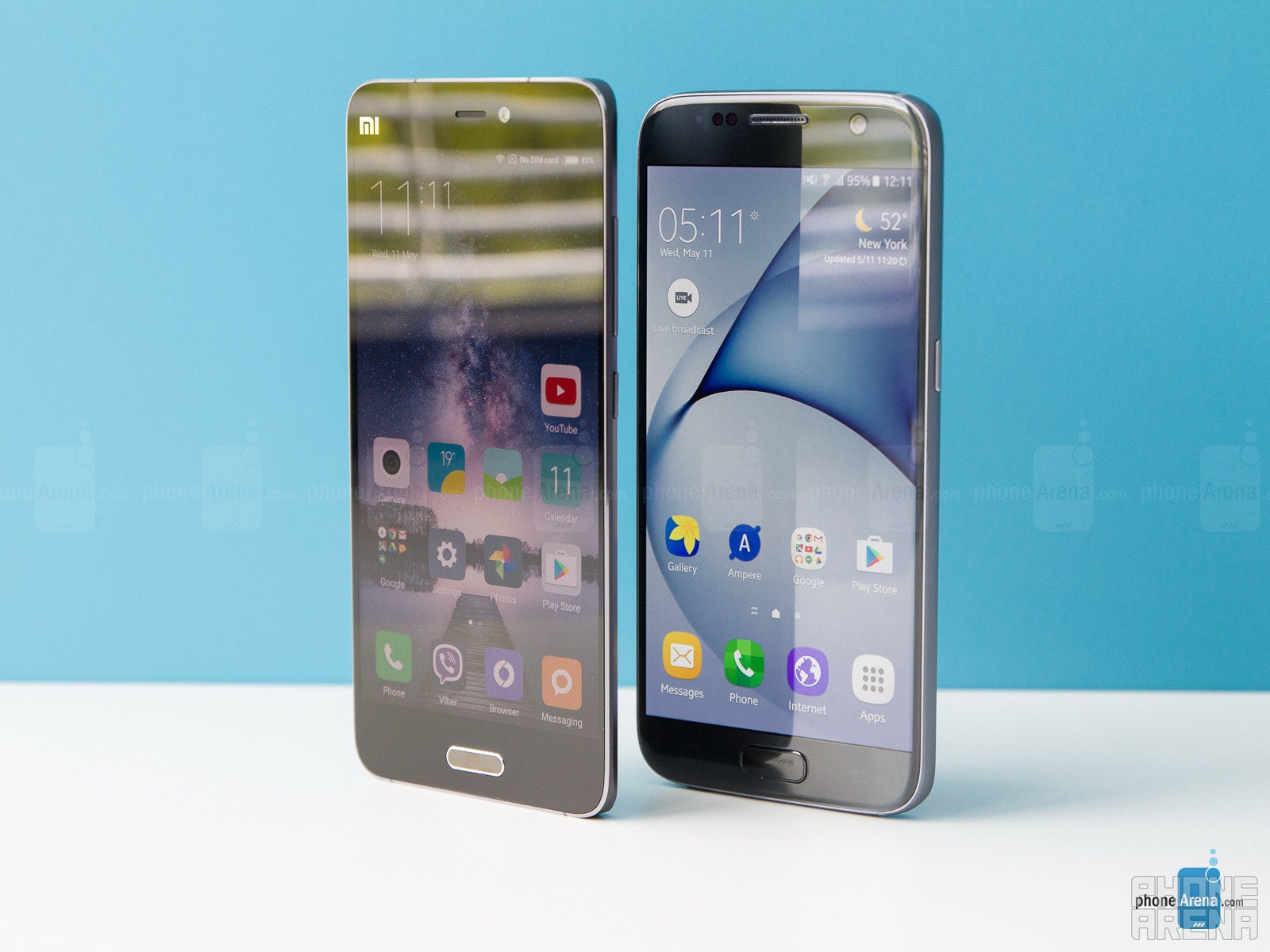
This is probably the biggest downside to owning a Xiaomi phone and it’s an important consideration. Now that you’ve been warned about all this, let’s keep it out of the way and focus on the performance of the Xiaomi Mi 5 as we pit it against one of the best Android phones available at the moment: the Samsung Galaxy S7.
Design
Both have a stylish, beautiful design with a tapered back, metal frame and a solid feel, but both are fingerprint magnets.
Who came first: the hen or the egg? The same question can be asked about the design of the Xiaomi Mi 5 and Samsung Galaxy S7. Thing is that both look similar to a very large degree: comparable in size, with a tapered glass back and metal frame. And of course, you can already hear the angry crowds shouting about the Chinese copying again, but don’t be so fast in your judgment.
While the Galaxy S7 shares the Galaxy S6 looks, and you might think that Xiaomi copied from Samsung’s appearance, the truth is that before that new Samsung Galaxy design language made its debut in spring 2015, Xiaomi had already released its Mi Note (in January 2015), which is in fact the first Android phone to have that tapered glass back/metal frame accents.
With that settled, let’s focus on the specifics of each phone. The Xiaomi Mi 5 is the lighter and thinner of the two. It’s remarkable how light this phone is, and despite having only slightly slimmer body, that slimness is noticeable. The Galaxy S7 – in stark contrast – has a very noticeable heft in the hand, with a much more solid feel, it’s almost built like a tank (if tanks were made of glass). The tapered back does wonders to make both rest very comfortably in the hand. It is such small details that make a huge difference in daily use, and we’re glad that both Samsung and Xiaomi paid attention to those.
Alas, both phones are fingerprint magnets: with a glass back on both that’s no surprise. If we were very discerning, we’d say that the back seems to look a bit messier on the Galaxy S7, but the Mi 5 also catches a ton of fingerprints.
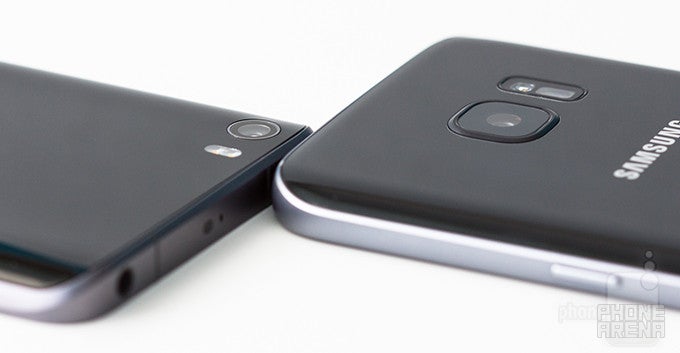
Little gets said about physical buttons, but we feel that’s an important topic: after all, you press them thousands of times. A hard-to-press button could not be a dealbreaker, but it’s a daily annoyance. The Xiaomi Mi 5 has its volume and power keys all on the right side, which subjectively feels like the right way to position them. The keys are light to press, but with sufficient travel and are very comfortable. The Galaxy S7 has its volume keys on the left and power key on the right, and all those buttons also have a remarkable, clicky feel, though they are not as light to the press.
Both phones also feature a fingerprint scanner right below the display. It’s a slimmer button on the Xiaomi Mi 5, while the S7 has the larger key, but both work extremely well. The Xiaomi Mi 5 is a bit faster: it’s almost a bit shocking to see the homescreen appear right after your register your fingerprint, while on the Galaxy S7 you first see the lock screen for a short while and then you are taken to the homescreen, and it’s a bit slower.
Yet, when it comes to the use and functionality of the fingerprint: Samsung is a step ahead with its international Samsung Pay system, while you simply cannot use your Xiaomi phone to pay for things, or at least not yet. We’re still far off from the times that we’d be all paying with our phones everywhere, but for many that’s a nice feature.
Then, there is waterproofing: the Galaxy S7 can take a short plunge in water and survive it, and that’s a great thing to have, while the Xiaomi Mi 5 lacks water protection.
Display
Two gorgeous displays: the Galaxy S7 has very accurate colors, while the Mi 5 has amazing high brightness that animates everything.
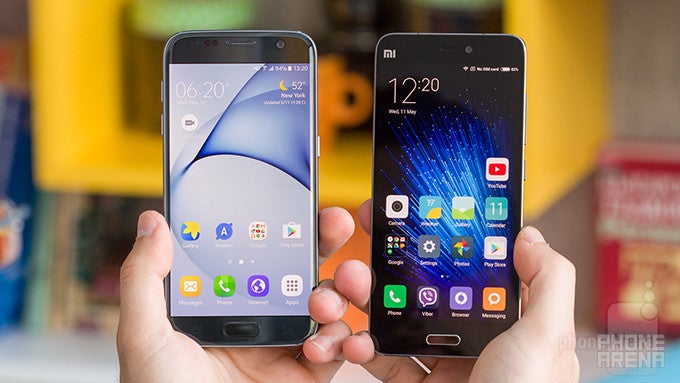
We’re dealing with two absolutely gorgeous screens here: the Galaxy S7 uses Samsung’s latest and best Super AMOLED technology in a 5.1” Quad HD (1440 x 2560 pixel) display, while Xiaomi Mi 5 has a very beautiful and vivid 5.15” Full HD (1080 x 1920 pixel) LCD display. While the Galaxy S7 is sharper on paper, it’s hard to notice much of a difference in detail or sharpness in real-life usage. To the regular viewer looking at his phone from a hand’s distance, both will likely appear equally sharp.
Resolution, however, is not the only thing that you should look for in a display. What’s much harder to measure, yet is of paramount importance, is the color representation. Colors on both look very, very good. We do some complex measurements to see whether the colors on smartphone screens fit the sRGB industry standard. When you put the Galaxy S7 in Basic screen mode (go into Settings > Display > Display Mode, and change it there), it fits those color targets nearly perfectly, resulting in a nearly perfectly balanced screen. The Mi 5 also gets close, but not as close in terms of accurate colors as the S7, but the difference is really minimal. Let’s emphasize that at the end of the day both screens have very, very good color representation.
It’s also astonishing how bright the screen on the Mi 5 gets: with a peak brightness of 638 nits, it blows the Galaxy S7 and its meager 484 nits of brightness right out of the water. Higher brightness results in a subjective perception of more vivid colors and that’s why everything on the Mi 5 appears very lively. Outdoors, the Galaxy S7 boosts its brightness to higher-than-usual levels, so it ends up as easy to read its display outdoors as on the Mi 5. Both phones are also capable of reaching a minimum brightness of just 1 nit on the Mi 5 and 2 nits on the S7, and those low level are particularly useful when you read on your phone at night and don’t want a way too bright display burning your eyes.
Interface
The MIUI interface is a flat UI with tons of advanced options: call recording, child mode, tons of customization tools, while TouchWiz on the S7 is the best TouchWiz so far.
Samsung’s custom TouchWiz user interface is probably the most recognizable face of the Android platform, despite the fact that it looks so different from stock Android. Then, there is Xiaomi’s MIUI 7 custom interface, based on Android 6.0 Marshmallow, but stripped out of an app drawer and with a vastly different iconography and styling.
Both phones are very prone to customization: both Samsung and Xiaomi support themes that let you change the wallpaper, icons and overall appearance of the platform.
Samsung’s Galaxy S7 in particular has a few novelties that you probably already know about: Game Center that locks the buttons so you don’t accidentally quit your game, and always-on display that shows you the time, calendar and notification counts right on the lockscreen.
Xiaomi lacks those two particular options, but it has a few tricks up its sleeve that are unmatched among major smartphones: you can, for instance, record all your calls automatically without the need for a third-party app, it has an absolutely stunning online wallpaper collection and the option to easily swap wallpapers which is neat, it has the useful, password-protected child mode, guest modes and Do Not Disturb settings. The Mi 5 also has a very easy to access one-handed mode that you activate by simply swiping left or right on the home screen (you can choose to slim down the interface to a 4.5”, 4” and 3.5”).
Internet and Connectivity
This could be a dealbreaker: the Mi 5 has very limited 4G LTE support. Chances are it won’t work in many European countries, while in the States it will fall back to 3G speeds.
The annoying tradition of bundling duplicate apps on even the best Android phones out there continues with the Galaxy S7 and Mi 5. The S7 features a custom Samsung browser as the first option, and Chrome as the second, while the Mi 5 sports its own browser and then again, Chrome. All of these browsers do a good job accessing the web. We find Chrome to be the fastest and we like the convenience of having synced bookmarks across phone and desktop.
Then, there is 4G LTE connectivity. And here’s where the Xiaomi fairytale ends with a bust: the Mi 5 only supports FDD-LTE bands 1/3/7, meaning it won’t be able to work properly on the 4G LTE networks in the United States and even in many parts of Europe (lots of European carriers run their networks on the support 3 and 7 bands, but also rely on band 20, which the Mi 5 does not support. If you’re in Europe check with your carrier in your area to see whether band 1, 3 and 7 will cut it for you).
The Galaxy S7 - in stark contrast - supports all major bands for its target markets and with full 4G LTE support you will get faster webpage loads and downloads.
Performance and Storage
Fast storage and tons of it on both phones. The S7 has microSD card slot, while the Mi 5 has no expandable storage.
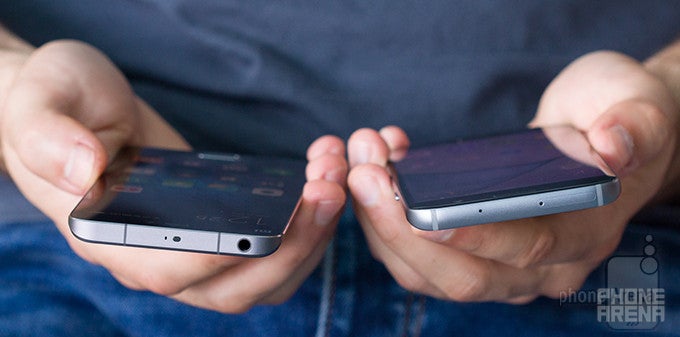
Both the Samsung Galaxy S7 and Xiaomi Mi 5 rock the latest and Qualcomm’s most powerful Snapdragon 820 system chip. But that’s not telling it all: the Mi 5 actually comes in three different versions with slight differences in the spec sheet as follows:
- Base Mi 5 (official MSRP ~$305) has Snapdragon 820 @ 1.8GHz, 3GB of RAM, 32GB of storage
- Mid-tier Mi 5 (official MSRP ~$335) has Snapdragon 820 @ 2.15GHz, 3GB of RAM, 64GB of storage
- Upper-tier Mi 5 (official MSRP ~$400) has Snapdragon 820 @ 2.15GHz, 4GB of RAM, 128GB of storage
We have the mid-tier version for review and it just flies. The MIUI skin is light on animations and where there are some they are extremely quick, and this gives the overall impression that the Mi 5 is really fast. When comparing it against the Galaxy S7, running a few apps side by side, we found that it is indeed faster in some applications, but in the majority of the apps, both phones work similarly fast. Still, that’s quite impressive for a phone that is selling for a much more affordable price than the S7.
Both phones are also great devices for gaming. The Mi 5 sports the Adreno 530 GPU, while the Galaxy S7 features either the same graphics chip or the Mali-T880 in its Exynos model that is sold outside the United States. Both phones score great in benchmarks and are future proof: games run well.
Having various model options for the Mi 5 is great and it’s not only the fact that Xiaomi offers a lot of storage charging little for the storage, but the type of the storage is also the fastest UFS 2.0, so app installs and everyday tasks happen faster. Of course, the Galaxy S7 features the same type of storage, but we’re just pleasantly surprised to see such a high-end feature on the more affordable Mi device.
Interestingly, the Mi 5 has a dual nano-SIM card tray, but does not support microSD cards to expand its storage, while the S7 has a hybrid SIM card slot that you can use for either two SIM cards or one SIM card and a microSD card. Good job on that front, Samsung!
Camera
The Galaxy S7 runs away with this: it’s mind boggling how fast and consistently good its camera is. Mi 5 is good, but slower and just not on that level.
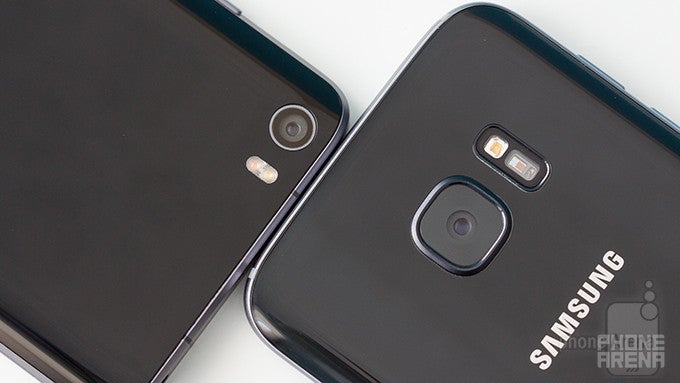
The Galaxy S7 has one of the best cameras on a phone, so the Mi 5 faces an uphill battle.
But first, let’s see what we’re dealing with in terms of cameras. The Galaxy S7 has a 12-megapixel camera with a 4:3 aspect ratio, a super wide f/1.7 lens, while the Mi 5 sports a 16-megapixel sensor with an f/2.0 lens. Both shooters have optical image stabilization (OIS), neat for sharper images in low light and steadier videos.

What about the image quality and camera experience? Put simply, it’s good on the Xiaomi Mi 5, but it’s so much better on the Galaxy S7. The fast Quick Launch shortcut is a wonderful thing to have, the camera focuses impressively fast and tracks that focus, and captures sharp images in various conditions. The Mi 5 is much slower to focus and we had some images turn out blurry, especially when we were trying to capture a moving object. Plus, the S7 is great for macros, while the Mi 5 simply cannot focus as close.
For all else, regular images in good light turn out with punch colors and a heavy doze of oversharpening on the Galaxy S7. This looks good for buildings and some everyday objects, but for people colors don’t appear all that flattering and that oversharpening can expose some not so pretty details. The Mi 5 also has slightly boosted colors, but nowhere near as oversaturated as the ones from the S7. Grass is greener on the Mi 5 and reds are redder, while on the S7 everything those colors tend to get a warm, yellow-ish tone. It’s the fast focus and very reliable images that give the S7 a definite advantage here, but speaking purely of color, the S7 images are a bit over the top.
For selfies, the S7 has a 5-megapixel front shooter, while the Mi 5 has a 4-megapixel camera. Megapixels largely don’t matter a dime these days: the really important difference between these two selfie cameras is that the one on the S7 has a super wide angle that can capture the whole family in a selfie easily, but if you want just yourself in the frame, it’s not as good. The Mi 5 has a narrower angle of view that makes filling the frame with your beloved self a much easier exercise, and those selfies definitely look better, but it’s harder to fill many people in the frame on the Xiaomi.
In terms of video, you have 4K video capture on both phones stabilized via an OIS system. If you shoot at 1080p you get additional software stabilization. All in all, the Galaxy S7 is the big winner here: colors are oversaturated, but focus is outworldly fast. The Mi 5 is a bit inconsistent and has lower detail and does not look as sharp. Still, stabilization is remarkable on the Xiaomi Mi 5: it is the first phone to have a 4-axis stabilization for smoother movements. Auto-focusing is a weak point on the Mi 5: the focus often hunts around.
Audio
Each the Galaxy S7 and Xiaomi Mi 5 features a single bottom-firing speaker that is not among the finest we’ve heard, but not bad either. The Galaxy S7 in particular has a very loud speaker, but it does lack depth. The Mi 5, on its part, has a quieter speaker that also does not have a very pronounced depth to it.
While we usually don’t pay too much attention to the power output from the headphone jack, it’s worth noting that the Mi 5 has an alarmingly low output of just 0.18 Volts. Complicated tech speak aside, this simply might not be enough to deliver enough volume and oomph to higher-end speakers or headphones.
Battery life
When it comes to battery life, both the Galaxy S7 and Mi 5 feature 3,000mAh, non-removable cells.
However, does that also mean that both last equally long? Not necessarily. We ran our intense custom test with both set at an equal brightness level and found that the Mi 5 lasts nearly an hour longer with longevity reaching 7 hours and 27 minutes, while the S7 lasts 6 hours and 37 minutes. Since both phones run the same Snapdragon 820 chip, the difference is likely due to the less power-intense Full HD display on the Mi 5 and more efficient app management. Great showing, Xiaomi!
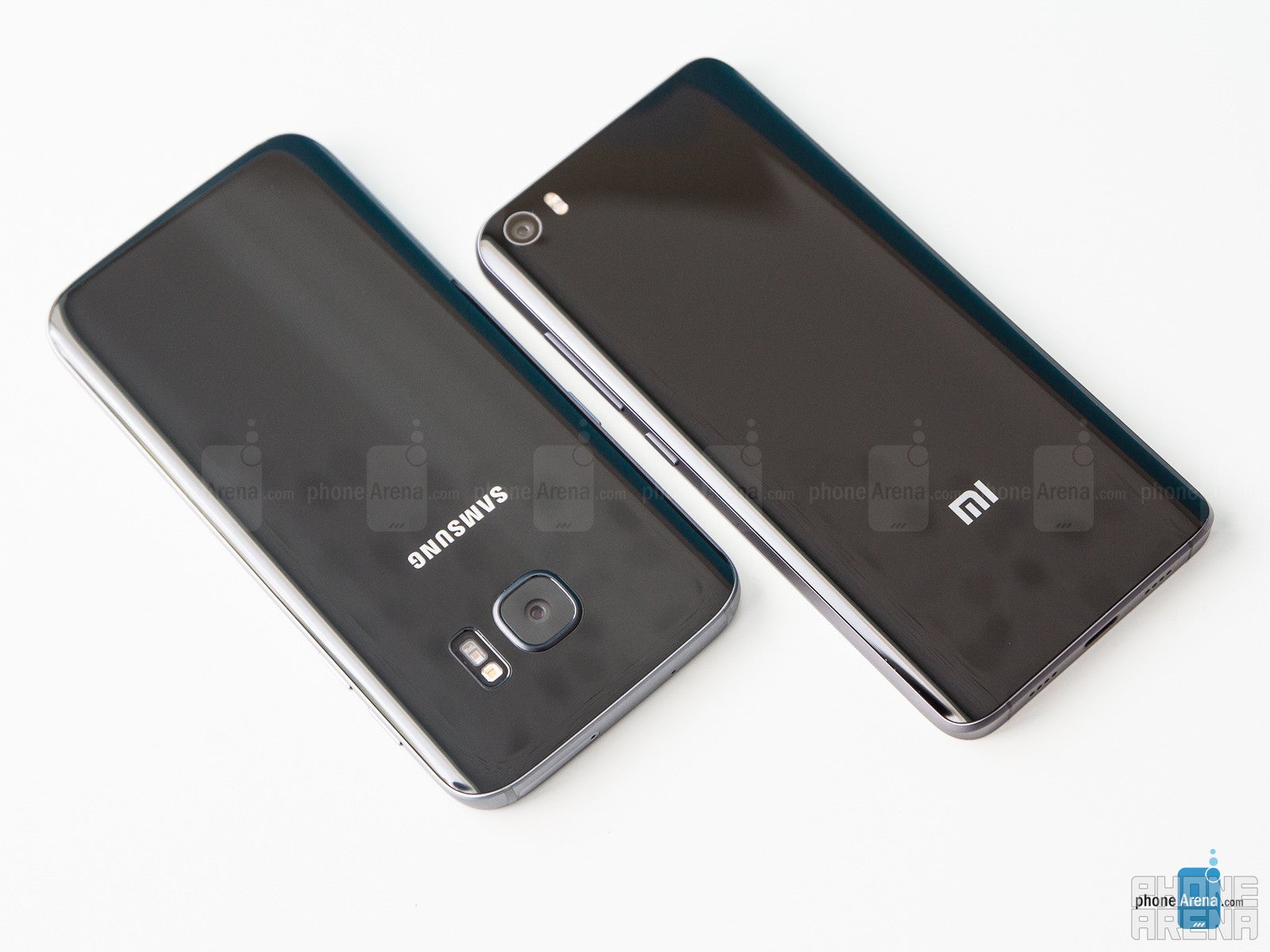
The Galaxy S7 also supports wireless charging, which is a neat option to have: you need a Qi compatible charger and you can place your S7 on that pad to refill it. The Mi 5, on its part, does not have wireless charging, but comes with the much easier, reversible USB-C port, while the S7 features a microUSB port.
Conclusion
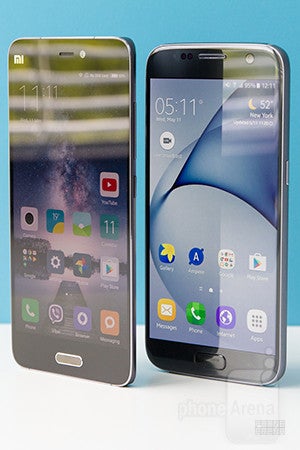
Assuming you’re aware of this risk, though, and you’re willing to wait often up to two weeks for the phone to ship from China, chances are that you’d be happy with the Mi 5. It’s a very sleek, impressively good-looking phone. It’s got the chops as well: the Snapdragon 820 chip inside flies on this thing (we recommend getting the mid-tier 64GB version with slightly faster version of the chip).
And it’s still much, much cheaper than the Galaxy S7 that starts at $700, a price difference of $250 when compared against the mid-tier Mi 5 model. The advantages of the Galaxy S7? A faster, more reliable, better camera; super fast quick charge capability and wireless charging; slightly better call quality; Samsung Pay and support for Samsung’s fun VR headsets; IP68 water resistance, expandable storage via microSD card support and… that’s about it.
We definitely enjoyed using both, but since we did not expect such a great showing from the Xiaomi Mi 5 we were pleasantly surprised by it. With all the limitations, it’s not for everyone, but if you are tired of all the same Samsung and Apple phones, the Mi 5 offers some nice variety, as long as you're willing to take the risks outlined above.
Xiaomi Mi 5
Pros
- Stylish, beautiful phone
- Bright and colorful display
- Cheaper than most other flagship phones
Samsung Galaxy S7
Pros
- Unlike the Mi 5, it is sold in the US and EU, with warranty and full LTE support
- Well-built, good-looking phone
- Great, high-resolution display
- Better camera experience
- Water-resistant phone
- Samsung Pay mobile payments

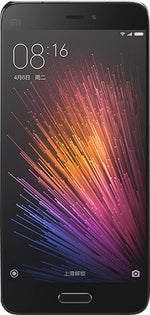











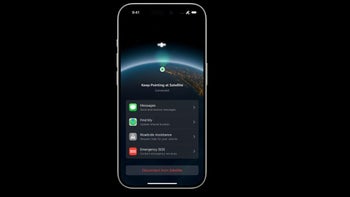







![T-Mobile is giving away free lines with (almost) no catches to make up for its imminent price hike [Updated]](https://m-cdn.phonearena.com/images/article/168477-wide-two_350/T-Mobile-is-giving-away-free-lines-with-almost-no-catches-to-make-up-for-its-imminent-price-hike-Updated.jpg)








Things that are NOT allowed: